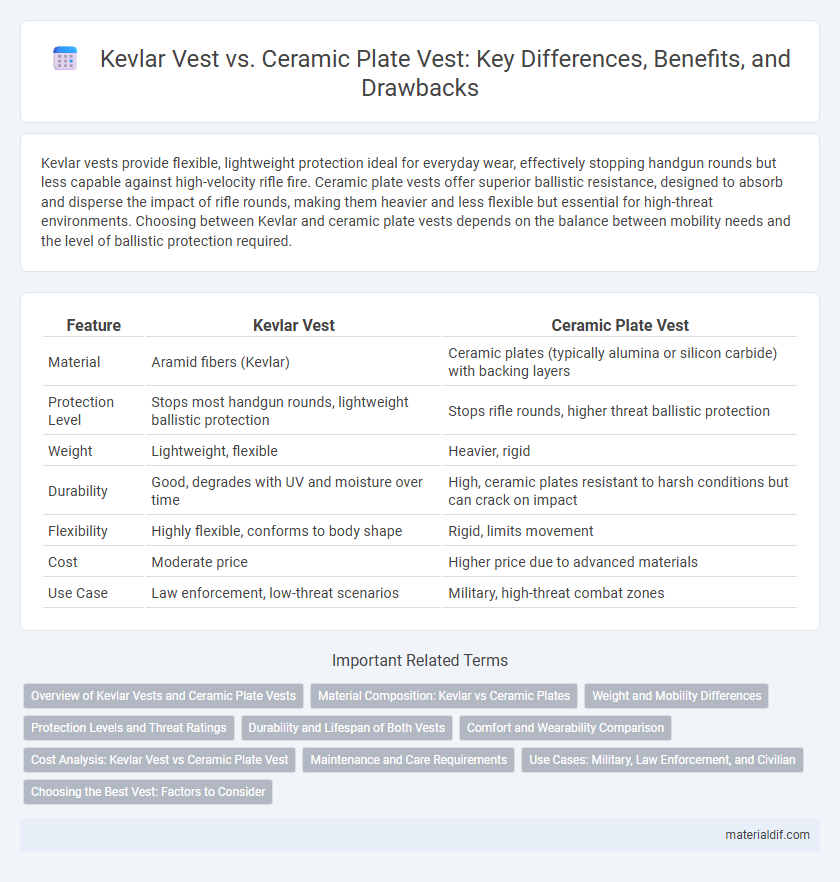Kevlar vests provide flexible, lightweight protection ideal for everyday wear, effectively stopping handgun rounds but less capable against high-velocity rifle fire. Ceramic plate vests offer superior ballistic resistance, designed to absorb and disperse the impact of rifle rounds, making them heavier and less flexible but essential for high-threat environments. Choosing between Kevlar and ceramic plate vests depends on the balance between mobility needs and the level of ballistic protection required.
Table of Comparison
| Feature | Kevlar Vest | Ceramic Plate Vest |
|---|---|---|
| Material | Aramid fibers (Kevlar) | Ceramic plates (typically alumina or silicon carbide) with backing layers |
| Protection Level | Stops most handgun rounds, lightweight ballistic protection | Stops rifle rounds, higher threat ballistic protection |
| Weight | Lightweight, flexible | Heavier, rigid |
| Durability | Good, degrades with UV and moisture over time | High, ceramic plates resistant to harsh conditions but can crack on impact |
| Flexibility | Highly flexible, conforms to body shape | Rigid, limits movement |
| Cost | Moderate price | Higher price due to advanced materials |
| Use Case | Law enforcement, low-threat scenarios | Military, high-threat combat zones |
Overview of Kevlar Vests and Ceramic Plate Vests
Kevlar vests are lightweight body armor designed with woven aramid fibers that provide flexible ballistic protection against handgun rounds and shrapnel. Ceramic plate vests integrate hard ceramic plates with soft backing materials, offering enhanced resistance against high-velocity rifle rounds and armor-piercing bullets. Both vest types serve distinct protective roles, with Kevlar focusing on mobility and blunt impact absorption, while ceramic plates prioritize penetration resistance for more severe ballistic threats.
Material Composition: Kevlar vs Ceramic Plates
Kevlar vests are constructed from aramid fibers known for their high tensile strength and flexibility, providing lightweight ballistic protection against handgun rounds. Ceramic plate vests incorporate hard ceramic materials like alumina or silicon carbide, designed to shatter incoming projectiles, significantly enhancing protection against rifle rounds. The combination of Kevlar's fiber weave with ceramic plates results in a balance of impact absorption, weight distribution, and multi-threat defense.
Weight and Mobility Differences
Kevlar vests offer superior mobility due to their lightweight fabric construction, typically weighing between 5 to 8 pounds, which allows for greater flexibility and comfort during extended wear. Ceramic plate vests, on the other hand, incorporate hard armor plates that can weigh 10 to 15 pounds or more, significantly reducing agility but providing enhanced ballistic protection against high-caliber rounds. The trade-off between weight and protection is critical, as Kevlar vests prioritize ease of movement while ceramic plate vests focus on maximizing defense, impacting wearer endurance and operational effectiveness.
Protection Levels and Threat Ratings
Kevlar vests typically provide protection at Level II or IIIA, effectively stopping handgun rounds and some fragments, making them suitable for low to moderate threat environments. Ceramic plate vests enhance protection by incorporating hard plates rated at Level III or IV, capable of defeating rifle rounds and armor-piercing bullets, ideal for high-threat combat scenarios. The choice between Kevlar and ceramic plate vests depends on the specific threat rating and required ballistic resistance outlined by the National Institute of Justice (NIJ) standards.
Durability and Lifespan of Both Vests
Kevlar vests offer high durability with flexible fibers that resist abrasion, maintaining effectiveness over several years under typical use conditions. Ceramic plate vests provide superior impact resistance by dispersing energy but may develop micro-cracks after repeated hits, reducing their lifespan compared to Kevlar. Lifespan for Kevlar vests can exceed five years with proper care, while ceramic plate vests often require replacement after one to three ballistic events to ensure optimal protection.
Comfort and Wearability Comparison
Kevlar vests offer greater flexibility and lighter weight compared to ceramic plate vests, enhancing overall comfort and ease of movement for extended wear. Ceramic plate vests, while providing higher ballistic protection, are heavier and less breathable, which can lead to increased fatigue during prolonged use. The choice between Kevlar and ceramic plate vests often depends on the balance between mobility requirements and protection levels needed in specific operational environments.
Cost Analysis: Kevlar Vest vs Ceramic Plate Vest
Kevlar vests typically cost between $300 and $800, offering lightweight protection suitable for low- to medium-threat environments. Ceramic plate vests range from $500 to over $1,500, reflecting their enhanced ballistic resistance against high-velocity rounds. The initial investment in ceramic plate vests is higher, but they provide superior multi-hit protection, potentially reducing replacement expenses in high-risk scenarios.
Maintenance and Care Requirements
Kevlar vests require minimal maintenance, needing only regular inspections for wear, tears, or moisture damage to maintain their protective integrity. Ceramic plate vests demand more careful handling due to the brittleness of ceramic materials, necessitating checks for cracks or chips that could compromise ballistic protection. Proper storage away from extreme temperatures and moisture is essential for both types to ensure long-term durability and effective performance.
Use Cases: Military, Law Enforcement, and Civilian
Kevlar vests offer lightweight flexibility and are commonly used by law enforcement officers for daily patrol due to their comfort and ability to stop handgun rounds. Ceramic plate vests provide enhanced protection against high-velocity rifle rounds, making them essential in military combat scenarios and tactical law enforcement operations. Civilians typically prefer Kevlar vests for concealed carry and personal defense, while ceramic plates are reserved for high-risk environments requiring maximum ballistic resistance.
Choosing the Best Vest: Factors to Consider
When choosing between a Kevlar vest and a ceramic plate vest, prioritize factors such as threat level, weight, and mobility requirements. Kevlar vests offer lightweight, flexible protection ideal for handgun threats, while ceramic plate vests provide superior defense against rifle rounds but are heavier and less comfortable. Consider operational environment and ballistic ratings like NIJ Level IIIA for Kevlar and Level III or IV for ceramic plates to ensure optimal protection.
Kevlar vest vs Ceramic plate vest Infographic

 materialdif.com
materialdif.com